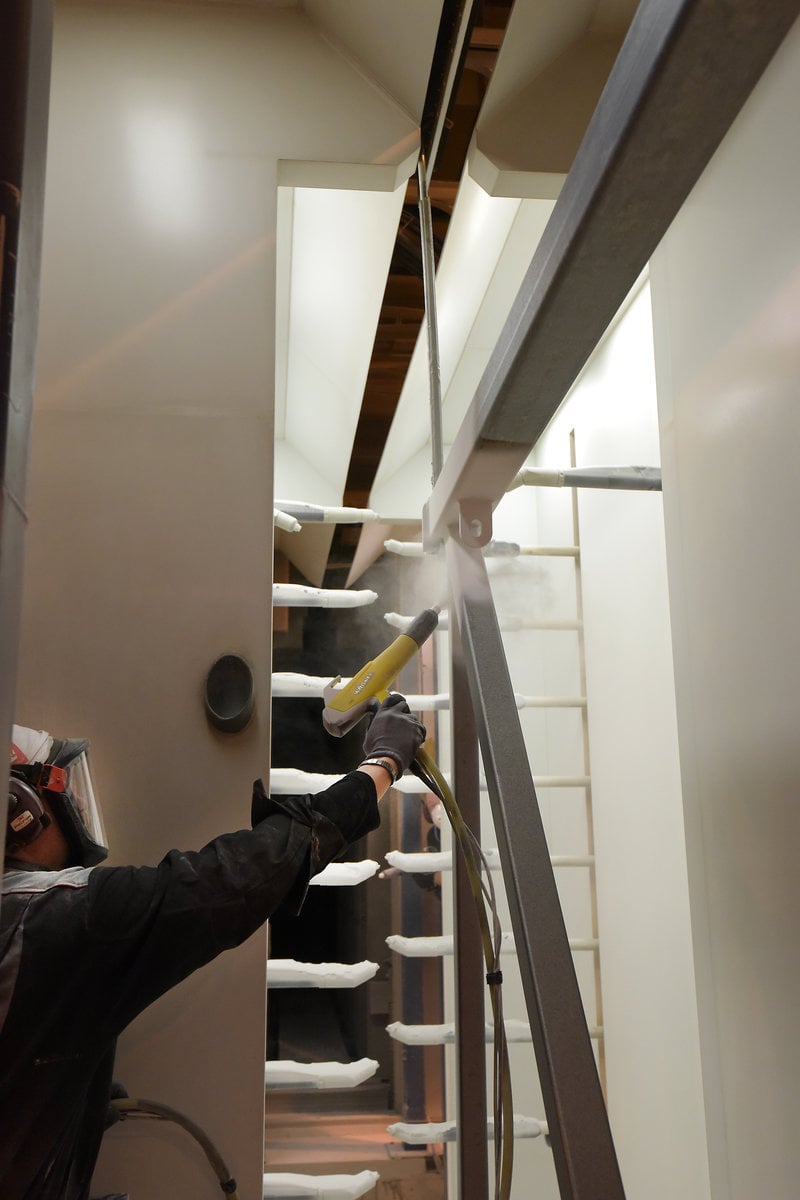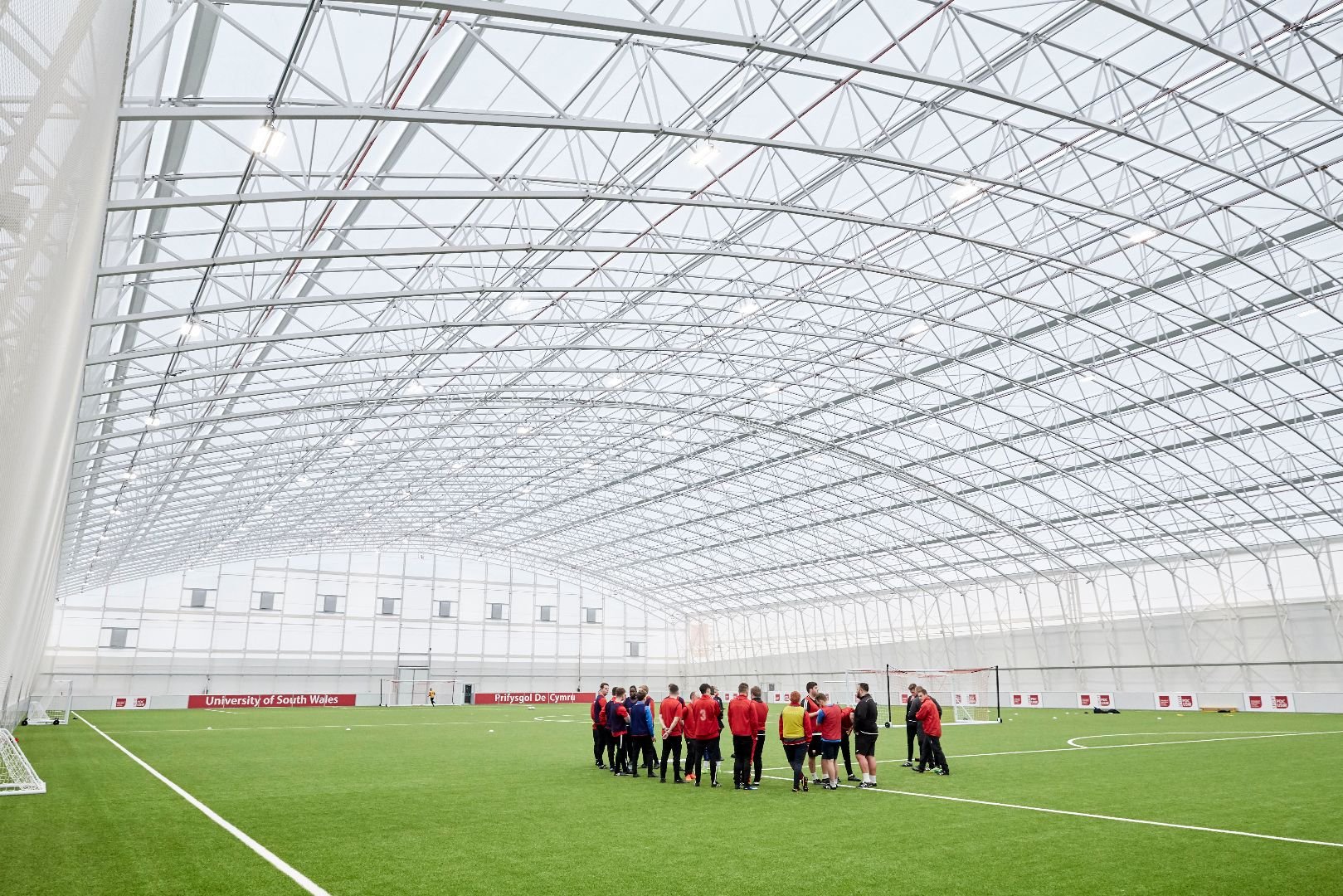27.10.2020
You can either hot galvanize or paint the steel frame of a PVC-covered building. Numerous tests, calculations and 45 years of experience have convinced us that powder coating the steel frame of PVC-covered buildings is superior to hot galvanising. Here are four key facts that show why we, as a pioneer in building construction, think powder painting is the best and a more environmentally-friendly way to protect building frames and construct buildings that will last several decades.
1) The cover fabric of a PVC-covered building will last longer
Powder coating makes a steel frame’s surface perfectly smooth and hard. The painted surface works wonderfully with PVC-coated cover fabric. The fabric will not wear out or become stained, no matter how hard it rubs against the steel frame.
Hot galvanizing often leaves the steel surface rough with potentially sharp irregularities. The cover fabric will always move slightly, especially in windy areas, airports and harbours, and heavy loads of snow push the fabric against the frame. A rough zinc coating chafes the fabric, which results in damage over the years. The cover fabric of our first buildings with powder-painted frames is as good as new, even after 30 years.
We only use galvanized steel for frames that do not come in contact with cover fabric. The hot-galvanized pipes we use in interior structures are manufactured on a continuous line that makes the pipe surface smoother than hot-dip zinc coating would.

2) Protection that endures level C4 and C5 corrosivity
Powder-painted steel frames can endure the conditions of corrosivity categories C4 and C5. In these conditions, the frame is under a significant environmental load due to acids, sea water or chemicals.
A building made of hot-galvanized steel with basic mixes can only be used in conditions with level C3 or lower corrosivity. Enduring category C3 conditions might suffice for some purposes, but we need to think about a building’s value in the long run. The low environmental category limits the number of potential end uses the building could have in the future.
If the frame of a building is powder-painted, the building can be used, for example, as a storage facility for artificial fertilisers, salt or chemicals; a composting and recycling building; a harbour warehouse or a swimming hall.
We coat our pipes with a zinc alloy mixed with magnesium and aluminium. This zinc coating has a significantly better resistance to corrosion than a traditional hot-galvanized coating.
3) Powder coating is eco-friendly
Hot galvanizing has been called environmentally friendly because it gives the galvanized frame a long useful life. But powder-painted steel frames have exactly the same useful life.
The preparation of zinc requires much more energy than the preparation of powder paint. The application process takes a great deal of energy as well. The zinc has to be first heated in a pot at approximately 420°C to melt it. The object to be galvanized is then dipped into the melted alloy. In powder painting, the object is heated up to 160°C. The paint sticks to the surface when the object is hot enough.
Hot galvanizing is a method that often requires additional trips to the galvanization facility, whereas powder painting can be done at the same location within our painting department. The overall carbon footprint of powder painting is indeed smaller.
To improve the eco-friendliness of our painting process, we switched over from spray painting to automated powder painting in 2013. Powder coating does not require the use of solvent substances, which improves our working conditions and reduces chemical discharges. The amount of paint waste was also significantly reduced. Furthermore, we use mechanical ball cleaning to clean steel surfaces, which produces less emissions than normal chemical cleaning.

4) Durable and easy-to-clean coating
Powder painting gives the steel frame stronger protection than other surface treatment methods. Tests carried out by Teknos show that a steel frame powder-painted with a double-layer finish endures even the most challenging conditions. According to adhesion tests, powder paint’s adhesive qualities when applied to steel are first class: the paintwork endured up to four times the standard strength requirement in the drawing test. This guarantees that rust cannot penetrate the painted surface under any conditions.
A smooth and hard powder-painted steel surface is also easy to clean. Frames are usually painted light grey, which makes the building feel more spacious and bright inside. But the RAL colour chart has many options to choose from. For example, sports halls built to be used in the UK are usually painted white to match the covering, and the end results have been beautiful. A porous zinc-coated surface absorbs dirt and is more difficult to clean because of the rough texture. Zinc-coated steel beams often end up tearing the fabric and staining it on the inside over the years.
For these same reasons, many of our customers have preferred their building to be powder painted. Read this article to find out how our Austrian customer Rema chose Best-Hall after learning more about structures and surface treatment methods.
Still not convinced? Contact us and we will tell you more about our powder painting method and test results!
Yhdystie 3-7,
68300 Kälviä, Finland
Tel: +358 6 832 5000
info@besthall.com
Business ID FI01070190